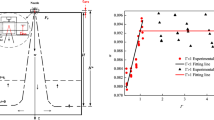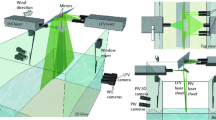Abstract
We describe a technique for measuring the layer thickness of two interacting buoyant rotating gravity currents. The technique can be used generally to differentiate between water masses in experiments with multiple sources and is used here to simulate the dynamics of two adjacent coastal river plumes. The plumes are generated using two identical fresh water inlets, with blue and red dye indicating upstream and downstream river flows, respectively. Two parameters, normalized intensity and color ratio, are measured with a 3-CCD color video camera and used to develop a two-dimensional (intensity–color ratio) calibration map for layer thickness. The calibration is used successfully to determine the depth field for the combined two-plume system and to differentiate between the two plumes. This technique is applied to compute the volumetric growth of a large eddy near the freshwater source and the transport rate of buoyant fluid away from the source in the coastal current. The validation tests show good agreement between the calculated plume volume and the input fresh water volume.














Similar content being viewed by others
References
Afanasyev YD, Rhines PB, Lindahl EG (2009) Velocity and potential vorticity fields measured by altimetric imaging velocimetry in the rotating fluid. Exp Fluids 47(6):913–926
Avicola G, Huq P (2002) Scaling analysis for the interaction between a buoyant coastal current and the continental shelf: experiments and observations. J Phys Oceanogr 32(11):3233–3248
Cenedese C (1998) Baroclinic eddies over topography. PhD thesis, University of Cambridge
Cenedese C, Dalziel S (1998) Concentration and depth field determined by the light transmitted through a dyed solution. In: 8th international symposium on flow visualization, pp 61.1–61.5
Cenedese C, Dalziel S (1999) Concentration and depth fields determined by the light transmitted through a dyed solution. Exp Fluids (submitted)
Cenedese C, Lerczak JA (2008) Understanding the dynamics of the interaction between two river plumes. In: Fifth international symposium on environmental hydraulics, pp 1–6
Chant RJ, Glenn SM, Hunter E, Kohut J, Chen RF, Houghton RW, Bosch J, Schofield O (2008) Bulge formation of a buoyant river outflow. J Geophys Res 113:C01017. doi:10.1029/2007JC004100
Cowen EA, Chang KA, Liao Q (2001) A single-camera coupled PTV technique. Exp Fluids 31(1):63–73
Fong DA, Geyer WR (2002) The alongshore transport of freshwater in a surface-trapped river plume. J Phys Oceanogr 32(3):957–972
Gonzalez RC, Woods RE, Eddins SL (2004) Digital image processing using MATLAB. Prentice Hall, Englewood Cliffs
Griffiths R (1986) Gravity currents in rotating systems. Annu Rev Fluid Mech 18:59–89
Griffiths RW, Hopfinger EJ (1983) Gravity currents moving along a lateral boundary in a rotating fluid. J Fluid Mech 134:357–399
Holford JM, Dalziel SB (1996) Measurements of layer depth during baroclinic instability in a two-layer flow. Appl Sci Res 56(2-3):191–207
Horner-Devine AR (2006) Velocity, density and transport measurements in rotating, stratified flows. Exp Fluids 41(4):559–571
Horner-Devine AR (2009) The bulge circulation in the columbia river plume. Pergamon-Elsevier Science Ltd, Oxford, pp 234–251
Horner-Devine AR, Fong DA, Monismith SG, Maxworthy T (2006) Laboratory experiments simulating a coastal river inflow. J Fluid Mech 555:203–232
Linden PF, Simpson JE (1994) Continuous releases of dense fluid from an elevated point source in a cross-flow. In: Beven KJ, Chatwin PC, Millbank JH (eds) Mixing and transport in the environment. Wiley, New York, pp 401–408
Nof D, Pichevin T (2001) The ballooning of outflows. J Phys Oceanogr 31(10):3045–3058
Tian XD, Roberts PJW (2003) A 3D LIF system for turbulent buoyant jet flows. Exp Fluids 35(6):636–647
Wedemeyer E (1964) The unsteady flow within a spinning cylinder. J Fluid Mech 20:383–399
Zhang X, Dabiri D, Gharib M (1996) Optical mapping of fluid density interfaces: concepts and implementations. Rev Sci Instrum 67(5):1858–1868
Acknowledgments
We thank Peter B. Rhines for suggesting the optical thickness method, and Eric G. Lindahl, Bob Koon, Bertrand Dano, and Kris Skotheim for their support in re-building the rotating tank and development of the technique. YY acknowledges the support of the Endowed Presidential Fellowship. MEA acknowledges the support of William and Marilyn Conner Graduate Fellowship. This research was supported by NSF grant OCE-0850847.
Author information
Authors and Affiliations
Corresponding author
Rights and permissions
About this article
Cite this article
Yuan, Y., Avener, M.E. & Horner-Devine, A.R. A two-color optical method for determining layer thickness in two interacting buoyant plumes. Exp Fluids 50, 1235–1245 (2011). https://doi.org/10.1007/s00348-010-0969-y
Received:
Revised:
Accepted:
Published:
Issue Date:
DOI: https://doi.org/10.1007/s00348-010-0969-y




